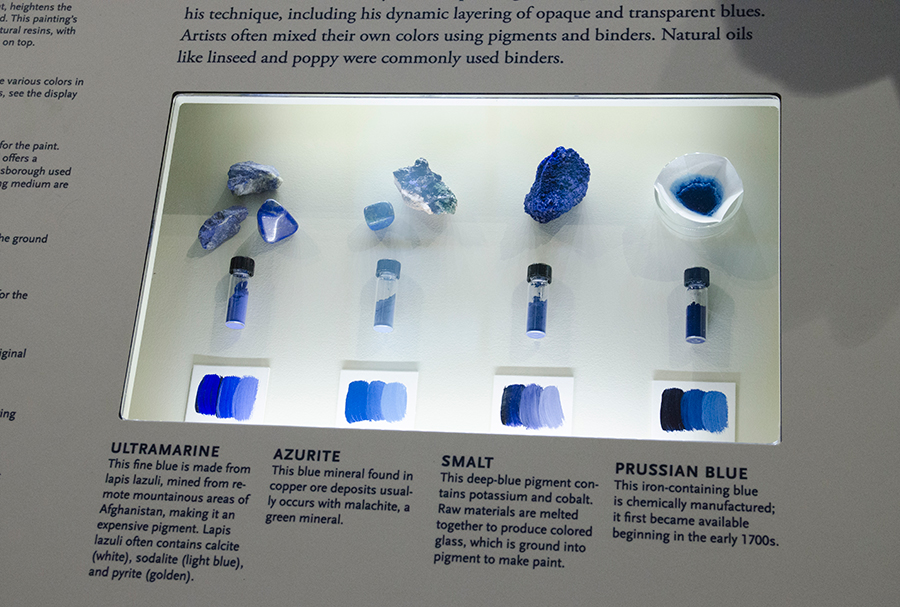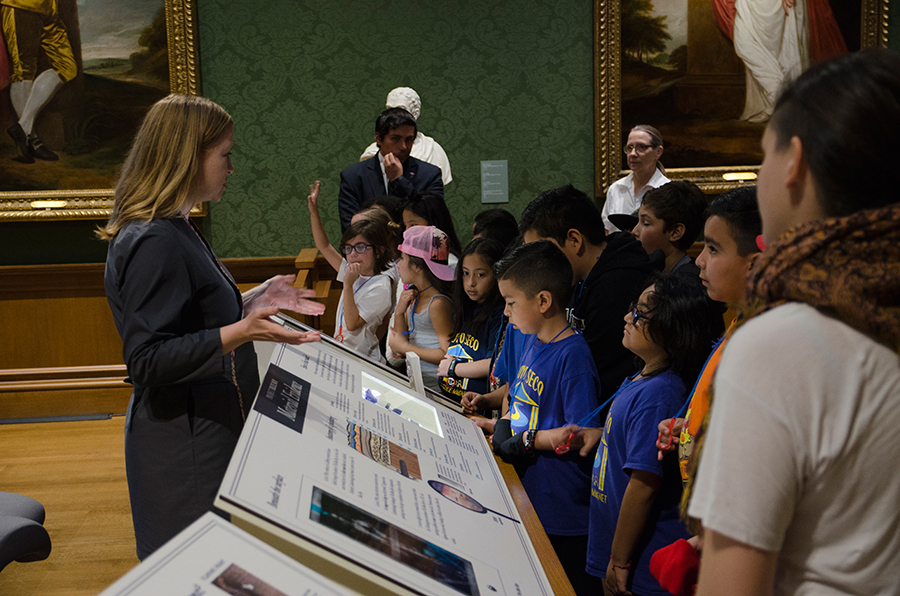The Huntington’s blog takes you behind the scenes for a scholarly view of the collections.
Deep Learning in the Science of Art Conservation
Posted on Wed., Jan. 23, 2019 by and

Christina O’Connell, senior paintings conservator, explains the blue pigments in The Blue Boy. Photo by Lisa Blackburn.
In October 2018, more than 100 students had the unique opportunity to immerse themselves in the world of art conservation as part of a Deep Learning Day developed by The Huntington's Education staff, focusing on the ongoing "Project Blue Boy" exhibition. Third-graders from two of The Huntington's partner schools—Rockdale Visual and Performing Arts Magnet and Arroyo Seco Museum Science Magnet, both in Los Angeles—spent a day at The Huntington exploring the science of art conservation. They met with Christina O’Connell, senior paintings conservator, for a lively Q&A session in the Thornton Portrait Gallery, where they talked about the conservation treatment O’Connell is performing on The Blue Boy (ca. 1770), the famous painting by Thomas Gainsborough (1727–1788). The students also engaged in some hands-on science by making sun prints to see how light impacts paper, conducting an assessment of sculptures in the North Vista, practicing the use of magnifying lenses to study objects up close, and learning about pigments, chromatography, and color mixing.
Before students visited The Huntington, staff members of The Huntington’s School Programs and Partnership team taught a lesson about “Project Blue Boy” at their schools. Students were introduced to the project, the role of conservation, and the blue pigments that comprise the young boy’s costume in the painting. Activities included creating a color wheel to explore mixing colors and learning such relevant vocabulary as “pigment,” “varnish,” and “preservation.”

This didactic panel—“How is Blue Made?”—shows students the four pigments of blue that appear in The Blue Boy. Photo by Lisa Blackburn.
The students were given a word search to practice their new vocabulary and a Blue Boy coloring page to practice using different blues. At the end of the class, one third-grade student captured the essence of the lesson: “Today I learned that there are four blues for ‘Blue Boy’ and they are smalt, Prussian blue, azurite, and ultramarine. I learned that they couldn’t buy paint back in the day.” Students also watched brief introductory videos about conservation.
When the students visited The Huntington, they spent the morning session of their Deep Learning Day talking with O’Connell in the Thornton Portrait Gallery. Having recently seen videos featuring O'Connell working in the gallery, several of the students gasped in recognition.

O’Connell talks to the students about conservation and “Project Blue Boy.” Photo by Lisa Blackburn.
During the day, students participated in six activities inspired by the “Project Blue Boy” exhibition’s didactic panels. Three activities reinforced the color wheel worksheet taught in the classroom: paint mixing to make tints, tones, and shades of blue; a chromatography experiment to discover which colors are made up of other colors; and a sun-printing exercise to better understand the effects of light on a work of art.
The other three activities encouraged students to step into the role of a conservator and employ tools similar to the ones O’Connell uses for “Project Blue Boy.” O’Connell talked to students about her work to remove non-original varnish from The Blue Boy and how she wields a large, surgical microscope to examine the painting.

Student interacting with the infrared refractology image of The Blue Boy on a display in the Thornton Portrait Gallery. Photo by Martha Benedict.
To experience varnish removal, students were provided with a laminated page covered with black scratch-off paint. With a conservator tool in hand—a popsicle stick—they carefully removed “varnish” (black paint) to unveil an image of The Blue Boy. Students also peered through microscopes, headband magnifiers, and magnifying glasses, marveling at brushes and canvases revealed in intimate detail.
When asked at the end of the day what they had learned, the young students were eager to share. “I learned that they hide the dog under rocks,” said one student, referring to an X-ray image of a small dog that appeared next to the boy before it was painted over because, the student explained, viewers “would pay too much attention to the dog, not the boy.”
Another student quipped: “Today I learned they crushed up rocks and glass [to make blue paint]. They also painted 'Blue Boy' with different shades of blue.”

The tools of a conservator, on display at the “Project Blue Boy” exhibition. Photo by Lisa Blackburn.
The following weekend, a student who attended the Project Blue Boy Deep Learning Day returned with her family to share her knowledge of the paintingand further engage with the senior conservator—which just goes to show that a little deep learning goes a long way.
Conservation of The Blue Boy and related educational programming are funded by a grant from the Bank of America Art Conservation Project. Additional generous support for this project is provided by the Getty Foundation, Friends of Heritage Preservation, Haag-Streit USA, and an anonymous donor.
Amanda Hernandez is the school partnership manager at The Huntington.
Kristin Brisbois is the school partnership and programs assistant at The Huntington.